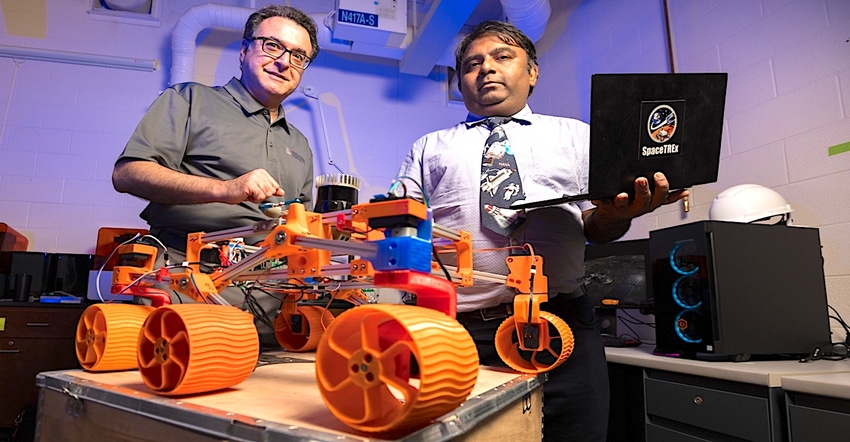Smart Robots Target Valuable Metals With Sophisticated Lunar Mining Techniques
NASA has tapped University of Arizona researchers to develop technology for mining lunar resources for human occupation.
September 27, 2021

Humans haven’t been to the moon since 1972, but scientists still have hopes not only of going back but also creating a base on the moon and other celestial bodies where one day people can live.
To help achieve this ambitious goal, researchers are developing swarms of autonomous robots that can mine the resources needed to build those bases. Specifically, NASA has awarded researchers at the University of Arizona (UofA) $500,000 in funding to advance space-mining methods using robot swarms made from 3D-printed parts.
The idea is that it would be far simpler to acquire resources needed from the moon itself rather than send it all the way from the earth, said researchers and engineering professors Jekan Thanga and Moe Momayez, who co-led the research.
Indeed, as scientists believe that the Earth and the Moon came from a common parent body, the moon should be rich in rare earth metals needed for technologies such as smartphones and medical equipment, titanium for use in titanium alloys, and precious metals such as gold and platinum. It also should have something that is rare on Earth--helium-3, a stable helium isotope that could fuel nuclear power plants, researchers said.
Unique Lunar-Mining Challenge
However, “nobody has ever set off a blast on the moon,” noted Momayez—and on earth, this is the most efficient way to drill through rocks, he said.
As the interim head of UofA’s Department of Mining and Geological Engineering and Chair in Mining and Geological Engineering, Momayez should know what it takes to mine the surface of a celestial object like the moon. Indeed, Momayez already has developed an electrochemical process to drill through rock five times faster than any other method.
Still, mining on the moon presents a new challenge, one he and his research partner Thanga plan to try to overcome.
"Here on Earth, we have an unlimited amount of energy to throw at breaking rocks," Momayez said. "On the moon, you have to be a lot more conservative. For example, to break rocks, we use a lot of water, and that's something we won't have on the moon. So, we need new processes, new techniques.”
![Lunar Mining Base (Anna Nesterova)[88] copy.jpg Lunar Mining Base (Anna Nesterova)[88] copy.jpg](https://eu-images.contentstack.com/v3/assets/blt0bbd1b20253587c0/blt385cb9eb816d19fd/65140fd91f554f7ed8e413d2/Lunar_20Mining_20Base_20_28Anna_20Nesterova_29_5B88_5D_20copy.jpg?width=700&auto=webp&quality=80&disable=upscale)
Training Robotic Swarms
As part of that challenge, Thanga, an associate professor of aerospace and mechanical engineering--is adapting a neuromorphic learning architecture technique called the Human and Explainable Autonomous Robotic System, or HEART, to create robot swarms that will be capable of mining lunar resources.
The system’s use will be not only to train robots to work together on mining, excavation, and even building tasks, but also to allow the robots to improve their collaboration skills over time. Training will happen on Earth so the robots can get the practice they need to become accomplished at their appointed tasks, Thanga said.
Once they are sent to the moon, however, the hope is that they will be a fully autonomous swarm that can achieve appointed goals for mining and construction without instructions from operators on Earth, he said, comparing the work of his team to farmers.
“We're breeding talent out of these creatures, or a whole family of creatures, to do certain tasks," he said in a press statement. "By going through this process, we help perfect these artificial creatures whose job it is to do the mining tasks."
The robot swarms aren’t meant to entirely replace humans, however, researchers said. Astronauts and other scientists and engineers will still be part of future space exploration teams; however, the robot swarms could perform the mundane tasks so humans can focus on other critical elements of missions, they said.
"The idea is to have the robots build, set things up and do all the dirty, boring, dangerous stuff, so the astronauts can do the more interesting stuff," Thanga said.
Elizabeth Montalbano is a freelance writer who has written about technology and culture for more than 20 years. She has lived and worked as a professional journalist in Phoenix, San Francisco, and New York City. In her free time, she enjoys surfing, traveling, music, yoga, and cooking. She currently resides in a village on the southwest coast of Portugal.
About the Author(s)
You May Also Like



